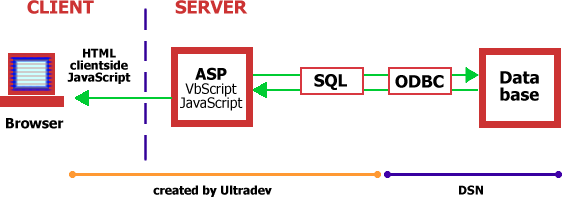this is a basic diagram of how the database connection via ASP/DSN works

|
if you want to retrieve, update, insert or delete data from the database, ASP achieves this by sending a SQL statement to the database. SQL stands for "Structured Query Language". it has the advantage that instead of having to learn all native languages of the databases you might use, you can use the same statement for all of them. in order to be understood correctly by the database the SQL has to be translated into the native database language via an ODBC driver. this works as well the other way round: data sent from the database to the ASP page is translated back into SQL by the ODBC driver. as an ASP developer you only have to worry about the SQL staement. the ODBC driver you simply install from elsewhere. one easy way to identify the proper driver for your database is to define a Data Source Name (DSN) via the ODBC panel on the machine you are working on. the Ultradev manual explains how to do this. once this DSN is defined for your machine you can create connetions in Ultradev using ADO (Data Source Name) and simply select the DSN from the list of available ones on your machine. this is quite straight forward. however, in some cases you might not be able to set up a DSN, e.g. if you are uploading your site to a remote server where you have no access to define one. in some cases your service provider (ISP) will create a DSN for you but in many cases you have to use another method to identify the right ODBC driver for your database which might even have some advantages in terms of connection speed (see www.activeserverpages.com ).
|